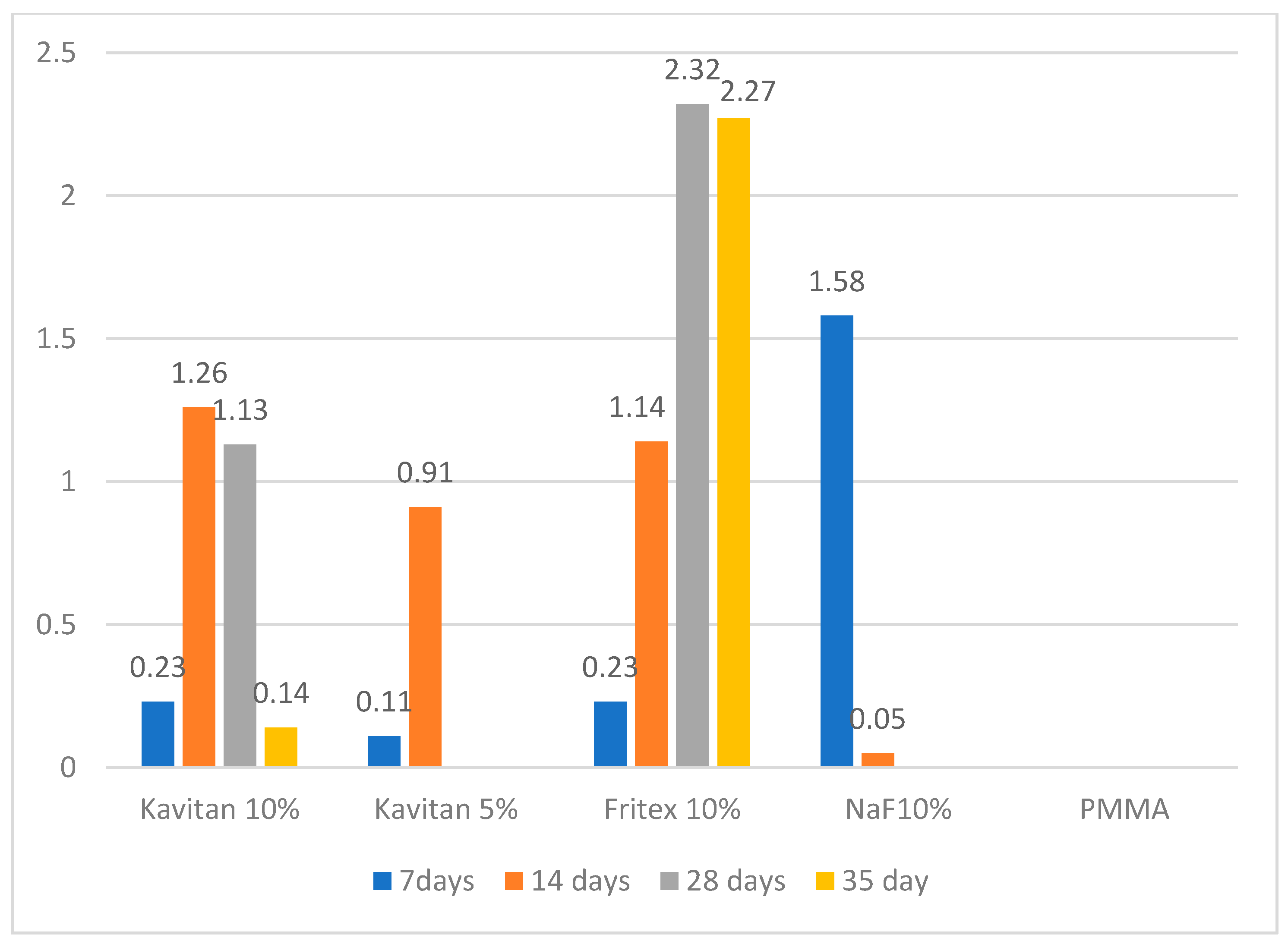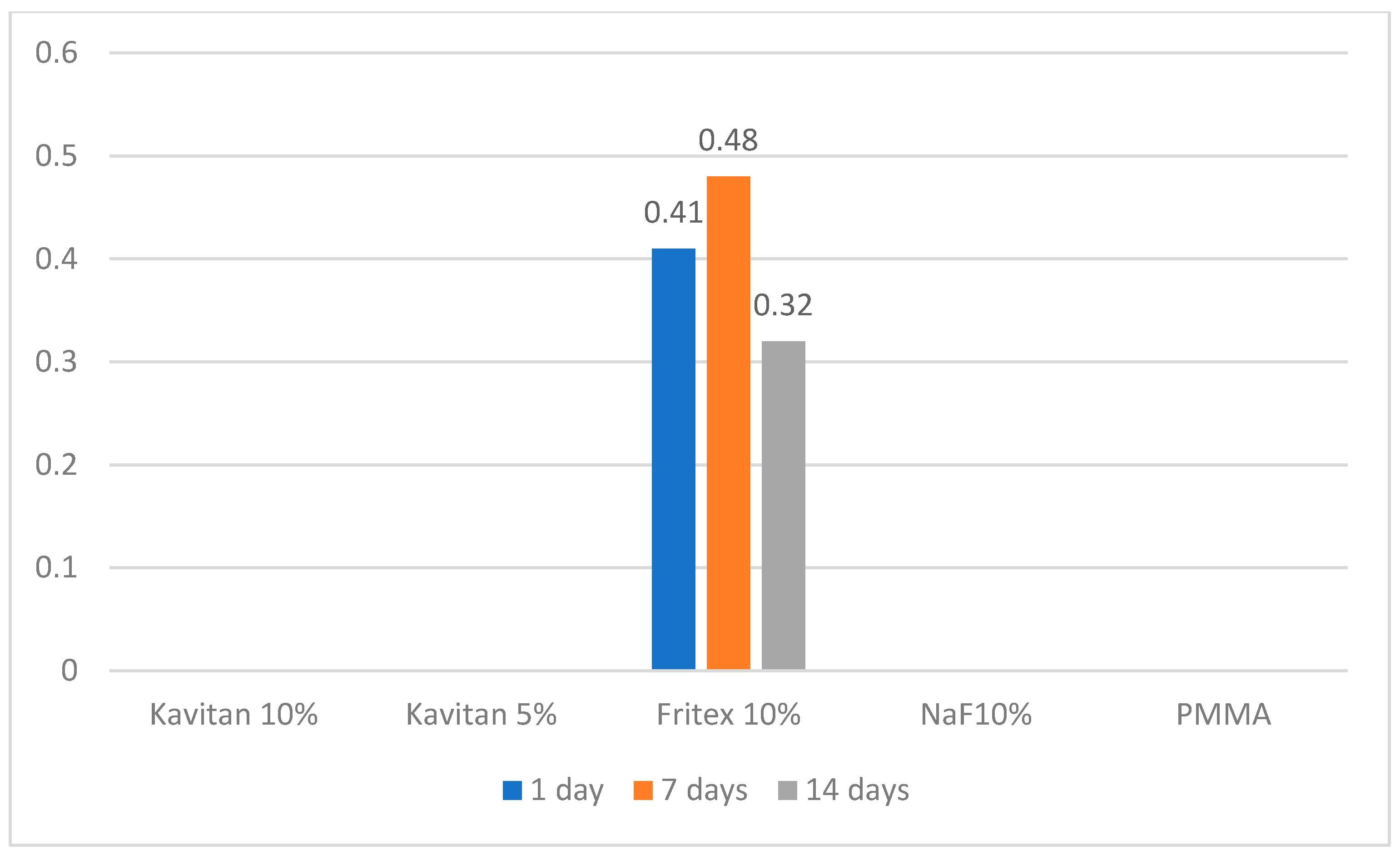Release and Recharge of Fluoride Ions from Acrylic Resin Modified with Bioactive Glass
Abstract
1. Introduction
2. Materials and Methods
2.1. Fluoride Ion Release
2.2. Recharge of Fluoride Ions
2.3. Sorption and Solubility
3. Results
4. Discussion
5. Conclusions
6. Clinical Significance
Author Contributions
Funding
Institutional Review Board Statement
Informed Consent Statement
Data Availability Statement
Acknowledgments
Conflicts of Interest
References
- Margolis, H.; Moreno, E.; Murphy, B. Effect of Low Levels of Fluoride in Solution on Enamel Demineralization in vitro. J. Dent. Res. 1986, 65, 23–29. [Google Scholar] [CrossRef]
- Nakornchai, N.; Arksornnukit, M.; Kamonkhantikul, K.; Takahashi, H. The pH effect of solvent in silanization on fluoride re-leased and mechanical properties of heat-cured acrylic resin containing fluoride-releasing filler. Dent. Mater. J. 2016, 35, 440–446. [Google Scholar] [CrossRef][Green Version]
- Featherstone, J.D.; Singh, S.; Curtis, D.A. Caries risk assessment and management for the prosthodontic patient. J. Prosthodont. 2011, 20, 2–9. [Google Scholar] [CrossRef]
- Burnett, G.; Nehme, M.; Parkinson, C.; Karwal, R.; Badrock, T.; Thomas, G.V.; Hall, P. A randomised oral fluoride retention study comparing intra-oral kinetics of fluoride-containing dentifrices before and after dietary acid exposure. Arch. Oral Biol. 2020, 119, 104891. [Google Scholar] [CrossRef] [PubMed]
- Ullah, R.; Zafar, M.S.; Al-Munawwarah, A.M. Oral and dental delivery of fluoride: A review. Fluoride 2015, 48, 195–204. [Google Scholar]
- Byeon, S.M.; Lee, M.H.; Bae, T.S. The effect of different fluoride application methods on the remineralization of initial carious lesions. Restor. Dent. Endod. 2016, 41, 121–129. [Google Scholar] [CrossRef] [PubMed]
- Zafar, M.S.; Al-Madinah, N.A.; Al-Munawwarah, A.M. Therapeutic roles of fluoride released from restorative dental materials. Fluoride 2015, 48, 184–194. [Google Scholar]
- Domagała, I.; Przystupa, K.; Firlej, M.; Pieniak, D.; Niewczas, A.; Biedziak, B. Bending Behaviour of Polymeric Materials Used on Biomechanics Orthodontic Ap-pliances. Materials 2020, 13, 5579. [Google Scholar] [CrossRef] [PubMed]
- Zafar, M.S. Prosthodontic Applications of Polymethyl Methacrylate (PMMA): An Update. Polymers 2020, 12, 2299. [Google Scholar] [CrossRef]
- Cochrane, N.; Cai, F.; Huq, N.; Burrow, M.; Reynolds, E. New Approaches to Enhanced Remineralization of Tooth Enamel. J. Dent. Res. 2010, 89, 1187–1197. [Google Scholar] [CrossRef]
- Verma, A.; Khurshid, S.; Parveen, F.; Khanna, S.; Pandey, P. Remineralization: An approach towards conservation of tooth. J. Evol. Med. Dent. Sci. 2015, 4, 10713–10719. [Google Scholar] [CrossRef]
- Van Loveren, C. Antimicrobial activity of fluoride and its in vivo importance: Identification of research questions. Caries Res. 2001, 35 (Suppl. 1), 65–70. [Google Scholar] [CrossRef] [PubMed]
- Flisfisch, S.; Meyer, J.; Meurman, J.; Waltimo, T.; Meurman, J. Effects of fluorides on Candida albicans. Oral Dis. 2008, 14, 296–301. [Google Scholar] [CrossRef] [PubMed]
- Naoum, S.; Ellakwa, A.; Martin, F.; Swain, M. Fluoride release, recharge and mechanical property stability of various fluo-ride-containing resin composites. Oper. Dent. 2011, 36, 422–432. [Google Scholar] [CrossRef]
- Harhash, A.Y.; El Sayad, I.I.; Zaghloul, A.G.S. A comparative in vitro study on fluoride release and water sorption of different flowable esthetic restorative materials. Eur. J. Dent. 2017, 11, 174–179. [Google Scholar] [CrossRef]
- Mitwalli, H.; Balhaddad, A.A.; AlSahafi, R.; Oates, T.W.; Melo, M.A.S.; Xu, H.H.K.; Weir, M.D. Novel CaF2 Nanocomposites with Anti-bacterial Function and Fluoride and Calcium Ion Release to Inhibit Oral Biofilm and Protect Teeth. J. Funct. Biomater. 2020, 11, 56. [Google Scholar] [CrossRef]
- Sidhu, S.K.; Nicholson, J.W. A Review of Glass-Ionomer Cements for Clinical Dentistry. J. Funct. Biomater. 2016, 7, 16. [Google Scholar] [CrossRef]
- Kiatsirirote, K.; Sitthisettapong, T.; Phantumvanit, P.; Chan, D.C.N. Fluoride-Releasing Effect of a Modified Resin Denture Con-taining S-PRG Fillers on Salivary Fluoride Retention: A Randomized Clinical Study. Caries Res. 2019, 53, 137–144. [Google Scholar] [CrossRef]
- Fujimoto, Y.; Iwasa, M.; Murayama, R.; Miyazaki, M.; Nagafuji, A.; Nakatsuka, T. Detection of ions released from S-PRG fillers and their modulation effect. Dent. Mater. J. 2010, 29, 392–397. [Google Scholar] [CrossRef]
- Mousavinasab, S.M.; Meyers, I. Fluoride Release by Glass Ionomer Cements, Compomer and Giomer. Dent. Res. J. 2009, 6, 75–81. [Google Scholar]
- Muñoz, C.R.D.; Ramírez Ortega, J.P.; Yamamoto Nagano, A. Fluoride release of two glass-ionomer cements: In vitro study. Revista Odontológica Mexicana 2014, 18, 213–221. [Google Scholar]
- Basso, G.R.; Della Bona, A.; Gobbi, D.L.; Cecchetti, D. Fluoride release from restorative materials. Braz. Dent. J. 2011, 22, 355–358. [Google Scholar] [CrossRef] [PubMed]
- Arbabzadeh-Zavareh, F.; Gibbs, T.; Meyers, I.A.; Bouzari, M.; Mortazavi, S.; Walsh, L.J. Recharge pattern of contemporary glass ionomer restoratives. Dent. Res. J. 2012, 9, 139–145. [Google Scholar] [CrossRef] [PubMed]
- Mukai, Y.; Kamijo, K.; Fujino, F.; Hirata, Y.; Teranaka, T.; Cate, J.M.T. Effect of denture base-resin with prereacted glass-ionomer filler on dentin demineralization. Eur. J. Oral Sci. 2009, 117, 750–754. [Google Scholar] [CrossRef] [PubMed]
- Kamijo, K.; Mukai, Y.; Tominaga, T.; Iwaya, I.; Fujino, F.; Hirata, Y.; Teranaka, T. Fluoride release and recharge characteristics of denture base resins containing surface pre-reacted glass-ionomer filler. Dent. Mater. J. 2009, 28, 227–233. [Google Scholar] [CrossRef]
- Al-Bakri, I.A.; Swain, M.V.; Naoum, S.J.; Al-Omari, W.M.; Martin, E.; Ellakwa, A. Fluoride release, recharge and flexural properties of polymethylmethacrylate containing fluoridated glass fillers. Aust. Dent. J. 2014, 59, 208–214. [Google Scholar] [CrossRef]
- Al-Bakri, I.A.; Harty, D.; Al-Omari, W.M.; Swain, M.V.; Chrzanowski, W.; Ellakwa, A. Surface characteristics and microbial adher-ence ability of modified polymethylmethacrylate by fluoridated glass fillers. Aust. Dent. J. 2014, 59, 482–489. [Google Scholar] [CrossRef]
- Tsutsumi, C.; Takakuda, K.; Wakabayashi, N. Reduction of Candida biofilm adhesion by incorporation of prereacted glass ionomer filler in denture base resin. J. Dent. 2016, 44, 37–43. [Google Scholar] [CrossRef]
- Tamura, M.; Cueno, M.E.; Abe, K.; Kamio, N.; Ochiai, K.; Imai, K. Ions released from a S-PRG filler induces oxidative stress in Candida albicans inhibiting its growth and pathogenicity. Cell Stress Chaperones 2018, 23, 1337–1343. [Google Scholar] [CrossRef]
- Ünal, E.I.; Kenar, A.; Aksu, M.L.; Taştekin, M. Spectrophotometric methods for the determination of fluoride ion using in-dole-3-acetic acid interaction with iron (III). Turk. J. Chem. 2019, 43, 415–423. [Google Scholar] [CrossRef]
- ISO. ISO 20795-1:2013 Dentistry—Base Polymers—Part 1: Denture Base Polymers; ISO: Geneva, Switzerland, 2013. [Google Scholar]
- Kamel, R.M.; Shahat, A.; Hegazy, W.H.; Khodier, E.M.; Awual, R. Efficient toxic nitrite monitoring and removal from aqueous media with ligand based conjugate materials. J. Mol. Liq. 2019, 285, 20–26. [Google Scholar] [CrossRef]
- Sjögren, K.; Birkhed, D. Factors Related to Fluoride Retention after Toothbrushing and Possible Connection to Caries Activity. Caries Res. 1993, 27, 474–477. [Google Scholar] [CrossRef] [PubMed]
- Duckworth, R.; Morgan, S. Oral Fluoride Retention after Use of Fluoride Dentifrices. Caries Res. 1991, 25, 123–129. [Google Scholar] [CrossRef] [PubMed]
- Sjögren, K. Toothpaste technique. Studies on fluoride delivery and caries prevention. Swed. Dent. J Suppl. 1995, 110, 1–44. [Google Scholar] [PubMed]
- Agarwal, B.; Dayal Singh, R.; Raghav, D.; Shekhar, A.; Yadav, P. Determination of Fluoride Release and Strength of a Fluoride Treated Heat Cured Acrylic Resin. EAS J. Dent. Oral Med. 2019, 1, 108–111. [Google Scholar]
- Sabir, D.; Omer, Z. Evaluation of Fluoride release from orthodontic acrylic resin by using two different polymerizations techniques: An In Vitro Study. Erbil Dent. J. (EDJ) 2019, 2, 149–156. [Google Scholar] [CrossRef]
- Benton, J.B.; Zimmerman, B.F.; Zimmerman, K.L.; Rawls, H.R. In vivo biocompatibility of an acrylic, fluoride-releasing, ani-on-exchange resin. J. Appl. Biomater. Off. J. Soc. Biomater. 1993, 4, 97–101. [Google Scholar] [CrossRef] [PubMed]



| Kavitan Glass | Fritex |
|---|---|
| SiO2 (26%) | SiO2 (44%) |
| Al2O3 (29%) | Al2O3 30% |
| F (10%) | F (6%) |
| P2O5 (8%) | P2O5 (3%) |
| Na2O (4%) | Na2O (6.0%) |
| SrO (17%) | CaO (5.0%) |
| Group | Quantity | Composition |
|---|---|---|
| P0 | 10 | Superacryl Plus (PMMA) |
| P1 | 10 | Superacryl Plus + 5 wt% Kavitan Plus glass |
| P2 | 10 | Superacryl Plus + 10 wt% Kavitan Plus glass |
| P3 | 10 | Superacryl Plus + 10 wt% sodium fluoride |
| P4 | 10 | Superacryl Plus + 10 wt% Fritex glass |
| Time | ||||
|---|---|---|---|---|
| Material | 7 Days | 14 Days | 28 Days | 35 Days |
| PMMA | nd | nd | nd | nd |
| PMMA + NaF | 1.58 ± 0.01 A a | 0.05 ± 0.02 A b | nd | nd |
| PMMA + Kavitan 5 wt% | 0.11 ± 0.01 B a | 0.91 ± 0.05 B b | nd | nd |
| PMMA + Kavitan 10 wt% | 0.23 ± 0.02 C a | 1.26 ± 0.02 C b | 1.13 ± 0.15 A b | 0.14 ± 0.05 A a |
| PMMA + Fritex 10 wt% | 0.23 ± 0.04 C a | 1.14 ± 0.02 D b | 2.32 ± 0.07 B c | 2.27 ± 0.06 B c |
| Material | 1 Days | 7 Days | 14 Days |
|---|---|---|---|
| PMMA | nd | nd | nd |
| PMMA + NaF | nd | nd | nd |
| PMMA + Kavitan 5 wt% | nd | nd | nd |
| PMMA + Kavitan 10 wt% | nd | nd | nd |
| PMMA + Fritex 10 wt% | 0.41 ± 0.01 A a | 0.48 ± 0.04 A a | 0.32 ± 0.05 A b |
| Material | Sorption | Solubility |
|---|---|---|
| PMMA | 10.23 ± 0.63 | 1.05 ± 0.11 |
| PMMA + NaF | 11.95 ± 0.33 * | 1.73 ± 0.15 |
| PMMA + Kavitan 5 wt% | 11.55 ± 1.25 | 1.51 ± 0.09 |
| PMMA + Kavitan 10 wt% | 12.11 ± 0.8 * | 1.59 ± 0.05 |
| PMMA + Fritex 10 wt% | 11.61 ± 0.07 | 1.19 ± 0.05 |
Publisher’s Note: MDPI stays neutral with regard to jurisdictional claims in published maps and institutional affiliations. |
© 2021 by the authors. Licensee MDPI, Basel, Switzerland. This article is an open access article distributed under the terms and conditions of the Creative Commons Attribution (CC BY) license (http://creativecommons.org/licenses/by/4.0/).
Share and Cite
Raszewski, Z.; Nowakowska, D.; Wieckiewicz, W.; Nowakowska-Toporowska, A. Release and Recharge of Fluoride Ions from Acrylic Resin Modified with Bioactive Glass. Polymers 2021, 13, 1054. https://doi.org/10.3390/polym13071054
Raszewski Z, Nowakowska D, Wieckiewicz W, Nowakowska-Toporowska A. Release and Recharge of Fluoride Ions from Acrylic Resin Modified with Bioactive Glass. Polymers. 2021; 13(7):1054. https://doi.org/10.3390/polym13071054
Chicago/Turabian StyleRaszewski, Zbigniew, Danuta Nowakowska, Wlodzimierz Wieckiewicz, and Agnieszka Nowakowska-Toporowska. 2021. "Release and Recharge of Fluoride Ions from Acrylic Resin Modified with Bioactive Glass" Polymers 13, no. 7: 1054. https://doi.org/10.3390/polym13071054
APA StyleRaszewski, Z., Nowakowska, D., Wieckiewicz, W., & Nowakowska-Toporowska, A. (2021). Release and Recharge of Fluoride Ions from Acrylic Resin Modified with Bioactive Glass. Polymers, 13(7), 1054. https://doi.org/10.3390/polym13071054







